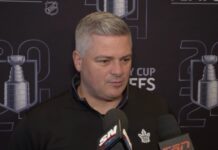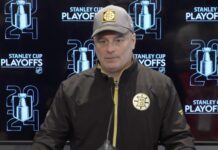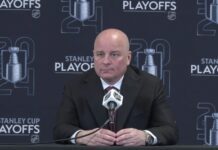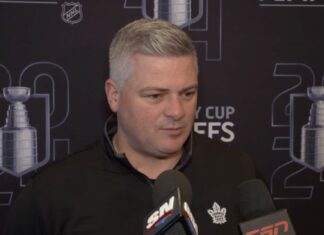Sheldon Keefe addressed the media after practice on Friday, discussing William Nylander’s excellent production of late, John Tavares’ semi-slump (five points in nine games), ice time distribution, and more.
How did the experience coaching William Nylander with the Marlies‘ impact how you’ve coached him now? What have you seen in his last 20 or so games that has led to such consistent offensive production?
Keefe: Like all the players I have coached before, you aren’t starting from scratch. You’ve got more experience and a bit of a relationship. It was a pretty short time with the Marlies — just the one season, and not even a full season — but it gives you more perspective on the player and all of that. I think it has helped me. I’m not sure it’s been a factor with any of the players, but just in the last little bit, he seems to be really confident and he is finding ways to get around the puck in good spots. He is making good on it.
Is that where his game has maybe grown the most— around the net? There was a perception he was a perimeter player. The numbers are suggesting otherwise.
Keefe: I think a lot of the times where you’re talking about him as a perimeter player is when he has the puck on his stick a lot. It is hard when you have it on your stick to find a way to the inside. The other team isn’t going to let you get there. Where he is having a lot of success now is, when others have the puck, he is putting himself in good spots so that when it does arrive at the net, he is there. He has figured that part out for sure, and it is helping him.
As the ice time of Nylander, Marner, and Matthews has gone up, those three, in particular, have shot up in production. Is that what you were looking for? What have you seen that has driven that for all three of them?
Keefe: Yeah, that is what I’ve wanted to see. I wanted to give those guys every opportunity or more opportunity to make the difference they felt they were capable of making. Part of that is ice time. Part of that is linemates. In Willy’s case, it was including him on the first power-play unit, which I think is more than just being on the unit and the production that might come from that. It is a little extra time on the power play. It is a little more inclusion when you are a part of it. That was the intent.
The other part of it is just with our style of play and how we are moving the puck around to try to keep the puck as much as we can — to keep it in the hands of the good players more often. We felt that those types of things could produce positive results for them and thus the team.
On the other side of that, John Tavares’ production has been a little bit quieter than the others. Is there something you are seeing in his game that maybe hasn’t been going as well since the break?
Keefe: We are looking at different things with him. I think part of it is he is playing with different lines — not just now, but even at the start of the year, and he didn’t get into much rhythm like he had the season previous playing with Mitch and Zach. Their injuries, his injury, and all of that sort of stuff disrupted his rhythm early. I think he obviously had great production last year. He is the type of player where I would expect that to continue. It doesn’t always work that way.
I think the reality is there is only one puck and we are scoring a lot. Focusing on who is scoring and how much guys are scoring, I think, is not productive for us. The things I am more focused on with John, in particular, as our captain and our leader, are all the little things he does very well for us. We are trying to establish purpose with our play and how we play both offensively and defensively. He is leading the way for us in a lot of regards there. At 6-on-5, he wins two massive faceoffs for us last game late in the game.
He wants to produce more. We’d like for him to find a way to have some of those chances fall in for him because he is still getting a number of chances that just hasn’t gone in maybe the way they did last season, but he does a lot of good things for our team and sets us up for success with his approach every single day. We need that to continue.
It is going to hit a point here where some of our other guys will maybe cool off and he will heat up. I think that’s just the way it will work.
You mentioned a few nights ago that one thing you learned about Mitch Marner is that he likes to play. He wants to play. When you are seeing him on the bench, what are you seeing? Eye contact?
Keefe: He gives you the little look over his shoulder wondering if he is next, and if not, “Why aren’t I?” kind of thing. Those are the cues you look for from your players. Those are your best guys. Because you are trying to gauge whether they are tired, sometimes they don’t want the next shift. They’re not giving you the eye contact — they might need a bit of a breather. You see their back a little bit because they still haven’t caught their breath. Those are the things you’re looking at. When a player gives you the eyes, he’s telling you, “I’m ready, so don’t slow this down anymore. Let’s get it going.”
Does Mitch ever get tired?
Keefe: It’s a great question because it doesn’t appear that he does, frankly. He is very smart with how he conserves his energy. He seems to be in great shape and seems to be able to go forever, whether it’s the power play minutes or the penalty kill minutes. Sometimes they overlap and there is not much downtime there for him, but he seems to be able to go.
How much of what you are doing as coach is trying to give them more confidence even than they already had, whether it is with ice time or with how you deal with him? How much of that is a conscious coaching strategy?
Keefe: Well, that is a big part of it. As I said, we’re trying to set our team up for success as a whole. Every single guy that we have is important. We don’t win without all 20 guys that are dressed in that particular game, or 19 if we only use the one goalie. Everybody has to have a purpose and a role. We believe we have that, but your best people have to be given an opportunity to get out there and get rhythm and feel good and have the puck. That is part of what confidence is — not necessarily whether the puck goes in or not but just that you’re out there and you’re engaged.
We want to make sure we’re allowing that to happen, but we also want to make sure we get sufficient ice time to the rest of our team, too. We know, especially down the stretch here with so much hockey being played, it is going to be tighter and tighter. We are going to need more from the rest of our bench. I am conscious of that the same time.
What is the biggest thing you’ve learned about Zach Hyman?
Keefe: I mean, I coached Zach, too, with the Marlies. He was just as effective of a player as us as he has proven to be at the AHL level in all facets. He was a dominant player for us just as you see here. I haven’t learned a lot of new, to be honest. I have come to expect just a top-notch work ethic and competitiveness. He has really worked at his skill set and confidence with the puck. There is not a lot of new with him.
He was black and blue in that series against Hershey. He didn’t hesitate to go to the net in some of those places.
Keefe: In the first year, statistically in goals, assists, and points, I am not sure where it all landed for him, but when we looked at his underlying numbers with the analytics, when he was on the ice, good things were happening for our team. That continues to be the case here.




![Sheldon Keefe Post Game, Leafs 3 vs. Bruins 2: “I loved [the Matthews] line, and I loved a lot about our game all the way through the lineup” Sheldon Keefe, Toronto Maple Leafs post game](https://mapleleafshotstove.com/wp-content/uploads/2024/04/keefe-pg-game-1-218x150.jpg)


























![Sheldon Keefe Post Game, Leafs 3 vs. Bruins 2: “I loved [the Matthews] line, and I loved a lot about our game all the way through the lineup” Sheldon Keefe, Toronto Maple Leafs post game](https://mapleleafshotstove.com/wp-content/uploads/2024/04/keefe-pg-game-1-100x70.jpg)



